In my last post, I compared General Petraeus’ slides to the Pentagon Report issued yesterday. In this post, I continue parsing their data by looking at two of their stacked bar graphs – notorious for obfuscation [though unlike General Petraeus, the Pentagon Report seemed to me like a genuine attempt to play it straight]. First, here’s General Petraues’ slide which was designed to show that attacks are down since the Surge:
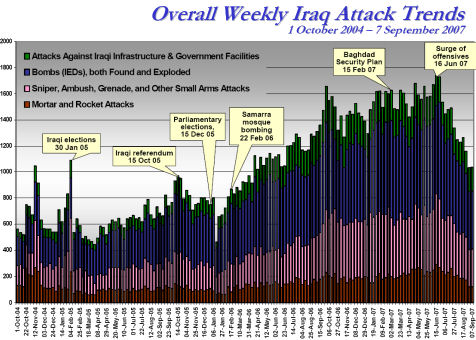
In the Pentagon Report, they showed a different version. Instead of breaking down attacks by weapon, they broke it down by who got attacked: Iraqi Civilians, Iraqi Military Forces, and Coalition Forces. Note the different scale – months instead of weeks:
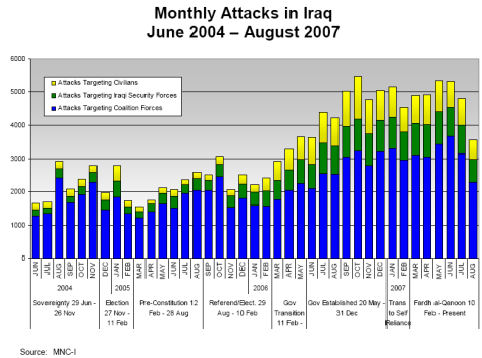
In the next graphic, I’ve redisplayed their data so we can more easily compare the three different groups being attacked: Iraqi Civilians, Iraqi Military Forces, and Coalition Forces. Note the political events along the bottom [helpfully] provided in the Pentagon Report:
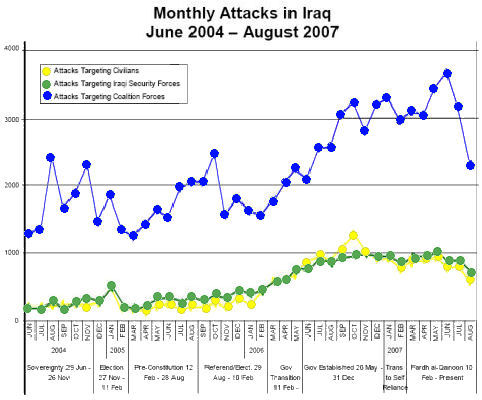
Does this alternative version of the graph tell us anything more. I think it makes some things, at least, clearer:
- Who is being attacked? The answer is obvious. We’re being attacked – that’s who. Most of the violence is directed against Coalition Forces [U.S. Soldiers].
- How about attacks against the Iraqi Forces? According to the data presented, Iraqi Military Forces are no more likely to be attacked than Iraqi Civilians.
- When did the violence escalate? The violence escalated in early 2006 when the new government was elected and began to take over. There were a number of things happening then – we turned over control to the Iraqis, we cut our troop levels drastically, their new government was barely functioning. This graph doesn’t allow one to make precise comments about what happened, but at the least, one can say that the coming of a democratic government lead to both an escalating Insurgency and to a a Civil War.
- How about the Surge? The Surge helped the Coalition Forces. There is a distinct effect on attacks against U.S. Soldiers. Were I either an Iraqi Civilian or a member of the Iraqi Army, I would say that it had precious little effect on the attacks we experienced.
Before delivering my 1boringoldman State of the War Report, I’d like to go back to the data I looked at in the last post. It’s from the Pentagon Report and shows the Average Daily Casualties, by month, also separated among Iraqi Civilians, Iraqi Military Forces, and Coalition Forces. Note: Their software used a different color code for this graph:
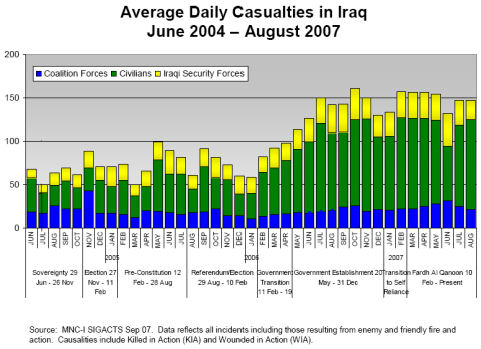
Again, deconstructing the stacked bar graph to compare the three groups:
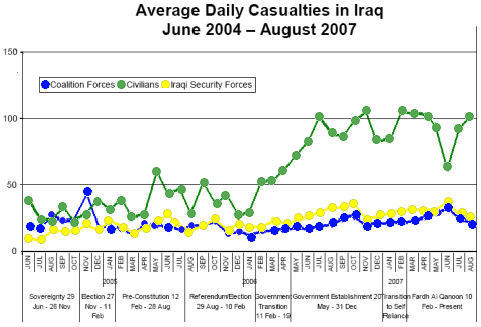
What does it say?
- Armed people are safer than unarmed people: To state the obvious, military people with guns and armor are safer than civilians, even though they’re more likely to be attacked [see above graph].
- This graph isn’t about "collateral damage." It’s about a Civil War: The escalation in violence was primarily felt by Iraqi Civilians – big time. While there’s been a mild increase in casualties in military forces since the coming of Iraqi Self-Rule, it’s the civilians who are suffering from their Civil War. Whether it’s ethnosectarian violence [executions] or just fighting in the streets, the plight of the Iraqi citizens under the new government has decidedly worsened. And except for the unexplained June respit, it proceeds unabated by any Surge, though the military casualties are falling.
I was just kidding about the 1boringoldman State of the War Report. I’m no DoD analyst. And I admit to being biased against this war from the outset – maybe even before that. These numbers represent real people who aren’t going to get to live, breath, think, make love, and die in their own time. That’s a colossal tragedy to my way of thinking. That said, I do have some comments about this data and our current situation:
|
Somebody in Iraq is attacking our soldiers, preferentially. As Yossarian said in Catch-22, "They’re shooting at me!"
It’s very clear that the escalation in violence followed the elections and formation of a new democratic government. So much for the Neoconservatives’ absurd premise that the world is full of supressed people longing to be liberated so they can have democracy just like us. Democracy is a ‘chosen’ form of government, and it gets ‘chosen’ by a moderately unified group of people. If there are successful examples of ‘imposed’ democracy, they don’t come to mind right now.
If we leave Iraq, what are the dangers?
If we stay in Iraq, what are the dangers? More of the same in Iraq and some version of a revolution in America.
The Surge: The Surge is neither successful nor unsuccessful. It’s irrelevant. In fact, in the long haul, we are irrelevant in what will happen in Iraq…
|
[See Juan Cole on TPM…]
Sorry, the comment form is closed at this time.